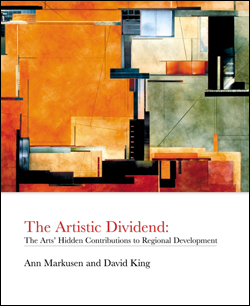The Artistic Dividend
The Arts’ Hidden Contributions to Regional Development

July 2003, 25 pages. Project on Regional and Industrial Economics, Humphrey Institute of Public Affairs, University of Minnesota, 301 S. 19th Avenue, room 231, Minneapolis, MN 55455, (612) 625-8092
Download:
![]() The Artistic Dividend (1.6Mb)
The Artistic Dividend (1.6Mb)
The Artistic Dividend takes an occupational approach to analyzing the economic impact of the arts. This innovative approach looks at artists as entrepreneurs, as vital contributors to the economy instead of as the result of a successful economy.
Traditional analyses of the economic impact of the arts focus on ticket sales and the number of art spaces, measures that understate the impact of the arts. Taking an occupational approach broadens this view to look at how artists' specialized skills enhance related sectors of the economy, including design, production, teaching, and touring.
This study focuses on artists who make a living at art work and analyzes the kinds of economic strategies that they use to build a career and market their work. These artists contribute to the economic base of their region not only when their goods and services are purchased within the local economy, but also by exporting goods and services out of the region, which enables the artist to earn an income to spend in the local economy.
Many artists are self-employed and often are not counted in government data on employment. However, the self-employed artist does have a significant impact on the economy. Artists can act like a small firm by hiring people for their skills in bookkeeping, research, marketing; patronizing suppliers of materials, printing, or agents; teaching their specialty; and therefore generating work for others in the economy. Many of these relationships are not tracked through job and sales data, but still have a strong impact on the economy.
Artists rely on these cooperative links as part of their entrepreneurial activity. The number of suppliers and buyers of goods and services that the self-employed artist uses is almost impossible to calculate, but has a tremendous effect on the entire business community.
Using data from the U.S. census, the authors tracked regions with large percentages of artistic occupations and analyzed shifts in the artistic concentrations within select metro areas. While traditional artistic centers such as New York and Los Angeles retained a large artistic pool, other regions such as Albuquerque and the Twin Cities showed a surprising growth during the last decade.
Using the Twin Cities area as an example, the study listed several reasons for the growth in artistic centers. Regions with a large philanthropic presence, both private and public, as well as "quality arts establishments" tend to draw artists. Also, regions high in amenities, such as safety, affordability, and a cultural environment, attracted a larger number of artists. This rich mixture of organizations, networks, and funding, which economists call an "agglomeration," creates an environment that supports artists and their activities.
The Artistic Dividend includes profiles of four artists who serve as illustrations of the entrepreneurial artist. These artists support themselves with their art, contribute to the economy by creating employment for others, and make a living in a non-traditional artistic metro center. The profiles put a face on the occupational approach of this study.
